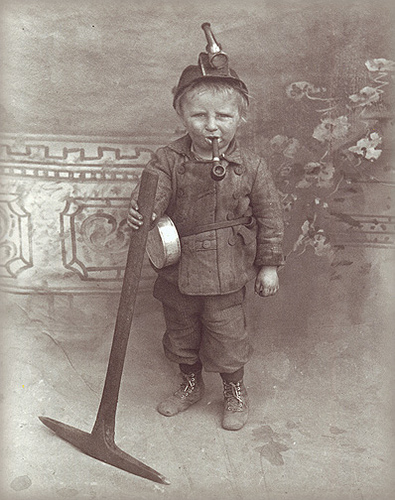This Friday, Nov. 13, marks the 100th anniversary of the Cherry Mine Disaster in Illinois, when an estimated 259 coal miners lost their lives to fire and the buildup of “black damp” or toxic gases. The St. Paul Coal Company Mine in Cherry was hailed by its consulting engineer as the “safest mine in the world.”
While we take time to reflect on the heroic sacrifices of coal miners and their families this week, the Cherry Mine Disaster remains a haunting reminder of the secret legacy of child labor in our coal mines — and its unconscionable use today.
Big Coal front groups like to peddle their “Coal is Cool” curriculum in schools — including a bizarre “Mars Invasion” project to help children play with the planning of coal camps on Mars — and disingenuous coal coloring books.
The Kid’s “Coal” Site at the Illinois Department of Commerce does not mention the Cherry Mine Disaster or child labor in the Illinois coal mines — but it does erroneously tell children that devastating strip mining and reclamation “is returning the land to the way it was or better than before mining” and that burned coal does not affect the environment, because “Technologies were developed to remove these chemicals from coal before, during, and after it is burned. These technologies are called clean-coal technologies.”
An estimated 27,000 children worked in American coal mines during the “period of disasters” in Cherry, despite child labor laws and age limits. Their horrific experiences as breaker boys have been chronicled by the Mine Safety and Health Administration.
Among the Cherry Mine dead were four children, who had been hired illegally. An estimated 470 children became orphans in Cherry. In Trapped: The 1909 Cherry Mine Disaster, author Karen Tintori notes, “the St. Paul Coal Company pled guilty to nine counts of child labor law violations and was fined a total of $630.”
That’s $70 a child — the worth of a child laborer in the coal mines in 1909. And today?
According to the Office of the United Nations High Commissioner on Refugees, child labor in coal mines continues in Pakistan, Mongolia, Nepal, Indonesia, and Colombia, where government agencies estimate that thousands of children are working in illegal mines. Last year, a Chinese blogger exposed the abuse of homeless children as coal haulers in China. In 2007, the BBC reported on child labor in coal mines of southern Kyrgyzstan near uranium dumps.
A British documentary crew recently aired a film, “Hell on Earth,” about the deathly conditions for children and families as coal scavengers and miners in northern India:
Child labor in the coal mines is not the only abuse of children from irresponsible coal companies. As the Miami Herald reported last week, legal representatives on behalf of villagers in the Dominican Republic have filed a suit against the Virginia-based AES company for birth defects related to coal ash dumping.
Here’s the video:
A report in the NY Times last month blew the cover on Clean Water Act violations by coal companies, and chronicled the impact of coal slurry on the health of children in Prenter, W.Va:
And today, the AP is reporting that the School Board Authority in West Virginia is now hedging on seeking funds for Marsh Fork Elementary School in West Virginia, which infamously sits below a massive coal slurry impoundment, and where kids play near toxic coal dust silos. Here’s a clip on retired coal miner Ed Wiley about the Marsh Fork school situation:
May we never forget the coal miners and children at the Cherry Mine Disaster.


